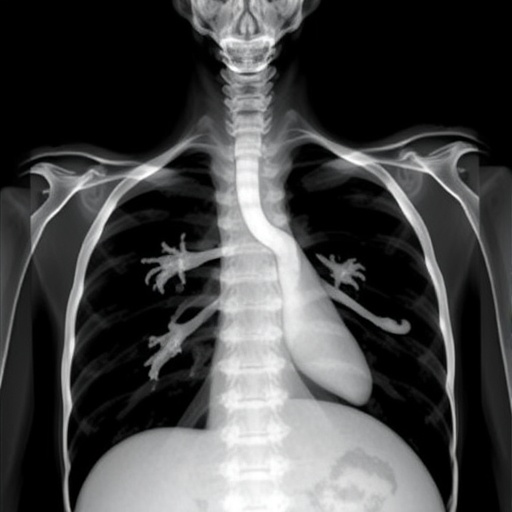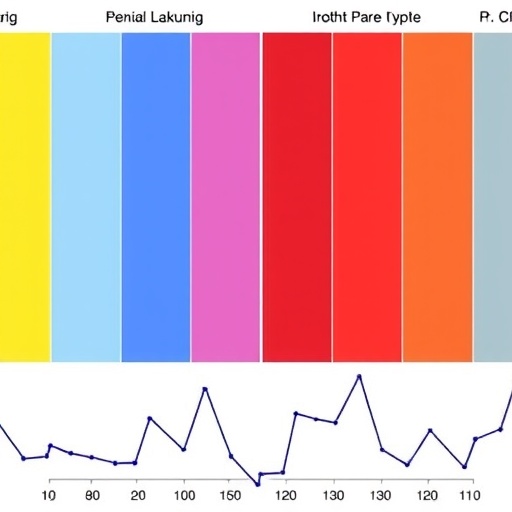In a remarkable new study that has captured the attention of the medical community, researchers explored a rare condition known as pulmonary agenesis, complicated by the presence of a tracheal bronchus in a 17-year-old patient. Pulmonary agenesis is a congenital anomaly characterized by the absence of one or both lung lobes, and it significantly impacts respiratory physiology and overall health. The study provides an in-depth examination of this complex and intricate condition, shedding light on both its clinical presentation and the considerations for management and intervention.
The case details reveal that the patient presented with unusual respiratory symptoms, prompting immediate medical evaluation. Upon detailed investigation, healthcare providers discovered the dual anomalies: the absence of a lung and the presence of a tracheal bronchus. A tracheal bronchus, an embryonic remnant, remains a hot topic in thoracic surgery and radiology due to its rarity and potential complications. The unique combination of these two anomalies presents a rare opportunity to understand and treat pulmonary conditions that are otherwise difficult to manage.
The investigation began with a thorough clinical assessment that utilized advanced imaging techniques, including high-resolution computed tomography (CT) scans. This diagnostic imaging is crucial in uncovering the architectural anomalies of the airways and lungs. The highly detailed scans enabled clinicians to visualize the tracheobronchial tree, where the tracheal bronchus could be identified arising directly from the trachea, instead of the standard branching pattern seen in most individuals. The findings from these scans raised both diagnostic questions and concerns regarding the patient’s future pulmonary function.
.adsslot_KUQ75Z9gP0{ width:728px !important; height:90px !important; }
@media (max-width:1199px) { .adsslot_KUQ75Z9gP0{ width:468px !important; height:60px !important; } }
@media (max-width:767px) { .adsslot_KUQ75Z9gP0{ width:320px !important; height:50px !important; } }
ADVERTISEMENT
From a physiological standpoint, the absence of lung tissue poses a myriad of challenges for respiratory mechanics. The body’s ability to oxygenate blood efficiently relies on the presence of functional lung parenchyma. In the case of pulmonary agenesis, the remaining lung must compensate for the lack of tissue, and the presence of a tracheal bronchus can complicate this compensatory mechanism. Clinicians must monitor oxygenation levels and respiratory function closely, as even minor respiratory infections could have life-threatening implications.
The management of a patient with such a unique anatomical configuration requires a multidisciplinary approach. Pediatric pulmonologists, thoracic surgeons, and radiologists must collaborate closely to develop an individualized treatment plan. The goal of intervention typically focuses on improving the quality of life and managing respiratory complications. This could include regular monitoring and potentially, surgical interventions to correct the airway anomalies, should they present with obstruction or other complications.
Throughout the case study, the authors emphasized the importance of genetic counseling and further research on congenital pulmonary anomalies. Genetic factors may play a significant role in the expression of pulmonary agenesis and other developmental anomalies, warranting thorough investigation. This understanding could potentially provide insights into the etiology and improve preventive strategies for such congenital defects.
Additionally, the educational aspect of this case cannot be understated. Medical students and practitioners can glean valuable insights into the diagnostic process and the intricate relationships between various anatomical structures. This knowledge is critical as it enhances diagnostic acumen and informs clinical decision-making when confronted with similarly complex cases in the future.
As this condition is exceedingly rare, the significance of sharing knowledge through publications cannot be overlooked. The study of cases like that of the 17-year-old boy fosters advances in the understanding of congenital diseases and enhances the clinical skills of medical professionals. Moreover, by documenting and reviewing atypical presentations, the medical community can collectively enhance patient management protocols and outcomes.
Case reports and analyses bridge the gap between theoretical knowledge and clinical practice, enriching medical literature, while contributing to ongoing discourse in pediatrics and respiratory medicine. The findings in this study are anticipated to spur further research studies investigating the pathophysiology, clinical impacts, and management of congenital pulmonary anomalies and their implications on long-term health.
In summary, the intricate case of pulmonary agenesis with a tracheal bronchus informs us about the complex interplay between congenital anomalies and respiratory function. The meticulous examination through advanced imaging technologies not only highlights the importance of careful diagnosis but also the necessity of collaboration among specialists to offer optimal care. As research continues to unfold, it could unveil new dimensions in understanding congenital defects, potentially leading to innovative treatments and better management strategies for future patients.
With the publication of findings associated with this unique case, there exists a promise for future advancements in pediatric radiology and pulmonology. Bridging knowledge gaps, fostering research, and sharing experiences will undoubtedly contribute to refining our understanding and management of pulmonary anomalies at large.
Moreover, this case exemplifies the need for further advocacy and education within the medical community regarding the existence of such conditions. Awareness leads to increased vigilance during patient assessments, encouraging healthcare providers to think beyond the standard presentations and consider rare conditions that might be lurking unnoticed.
In conclusion, the insights gathered from the study of this 17-year-old patient with pulmonary agenesis and tracheal bronchus are invaluable. They emphasize the fusion of clinical practice and academic research that drives the evolution of medicine, ultimately leading to improved patient care and outcomes.
Subject of Research: Pulmonary agenesis with tracheal bronchus in a 17-year-old patient.
Article Title: Pulmonary agenesis with tracheal bronchus in a 17-year-old
Article References: Akkuş, A.T. Pulmonary agenesis with tracheal bronchus in a 17-year-old.
Pediatr Radiol (2025). https://doi.org/10.1007/s00247-025-06331-1
Image Credits: AI Generated
DOI: https://doi.org/10.1007/s00247-025-06331-1
Keywords: pulmonary agenesis, tracheal bronchus, congenital anomalies, pediatric pulmonology, case study
Tags: advanced imaging in thoracic surgerycongenital lung anomaliescongenital respiratory disorders diagnosishigh-resolution CT scan applicationsmanagement of rare pulmonary conditionsmedical evaluation of respiratory symptomspatient case report in pulmonary medicinepulmonary agenesis case studyrespiratory physiology disordersthoracic radiology insightstracheal bronchus complicationsunique respiratory system abnormalities





